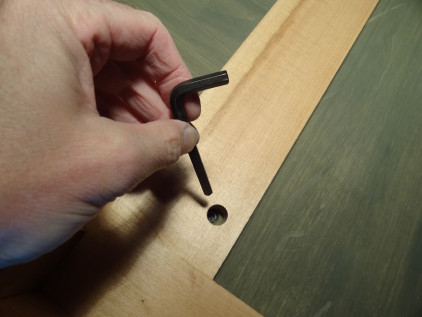Technical Library
KEYBOARDS VII: Keyframe height adjustment
Entire Contents Copyright © 2012 CBH
Technical LibraryKEYBOARDS VII: Keyframe height adjustment Entire Contents Copyright © 2012 CBH |
 CAREY BEEBE |
| Keyframe height adjustment screw through instrument bottom, accessed through hole in table stand |
Keyframe height adjustment…
Extreme seasonal weather changes in some parts of the world can wreak havoc on harpsichord regulation. With the arrival of summer humidity, the case sides expand, and the keyframe and action is effectively lowered in relation to the stringband. The same thing can happen if your harpsichord has to move from its familiar surroundings to a different climate.
With rise in humidity, the quills have too far to travel before they can engage with the strings. For those instruments where the keydip is stopped by the top of the jacks hitting the cloth on the underside of the jackrail, the keydip is also increased. (The accidentals when played must never bottom out below the level of the naturals!) It is useful to have some means of adjustment to easily bring the keyframe to its correct position with the strings, and be reverted when humidity conditions return to normal.
The jack designs of many twentieth-century revival harpsichords were encumbered by multiple screw adjustments, and of course the jack bottom screws provide a means of making this seasonal adjustment. It is rather cumbersome, though, to have to pull out each jack and unscrew the one hundred and eighty nine bottom screws of a 63-note French Double a small and even amount.
It is better to provide quick and effective global adjustment of the entire keyframe with large diameter screws through the bottom of the instrument bearing close to the rear corners of the keyframe to raise it above the bottom. Many makers now do this. If your instrument has this facility, two screw heads will be visible a little in from cheek and spine in treble and bass, directly under the jacks. The only tool required might require a normal or Phillips screwdriver, or an Allen key (typically 6mm or 1/4˝). If your harpsichord rests on a table stand, clearance holes should have been provided by the maker so adjustments can easily be made without having to move the harpsichord off the stand.
To make the necessary adjustments when the summer humidity comes, lift the jackrail so you can clearly observe the lost motion on top of the 4´ quills when you gently play the top treble notes. This is detected by eye as well as feel. Of course, there must be space on top of the quill to allow the tongue to flip back and the quill to return below the string. In humid times, often an eighth- to quarter-turn clockwise of the treble adjustment screw will suffice. If you go too far, the quills may not want to reliably return below the strings. Then check in the same manner for the bass, where a little more adjustment is sometimes required because you also have the effect of the soundboard rising with the humidity. You may need to remove a damper or two to ensure that the jacks are not being suspended above the key.
When drier weather returns, the case begins to shrink and the keyframe must be lowered again. Often the first indication this is necessary can be heard when the dampers are no longer silencing the strings because the jacks are effectively too tall, or—in extreme circumstances—many of the quills don’t return below the strings. Again, remove the jackrail and verify the need by eye as well as feel.
If your instrument does not have keyframe height adjustment screws, it is possible to raise the entire keyframe by card or veneer shims, and remove them again in drier times: Ask your maker. The jacks need to be lifted so the keyboard(s) can be removed. If there were no shims originally provided by the maker which could be removed to lower the keyframe, it is possible to fit them or the global adjustment screws through the bottom, but the jacks will require shortening so there is height adjustment available both up and down.
| Technical Library overview | |
| Harpsichords Australia Home Page |